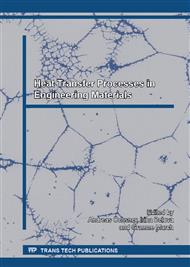[1]
J. M. Gordon and K. Choon: Predictive and diagnostic aspects of a universal thermodynamic model for chillers. Int. J. Heat Mass Transfer 1995; 38 (5): 807-818.
DOI: 10.1016/0017-9310(94)00208-d
Google Scholar
[2]
S. Göktun: Design considerations for a thermoelectric refrigerator. Energy Conversion and Management 1995; 36 (12): 1197-1200.
DOI: 10.1016/0196-8904(95)00005-x
Google Scholar
[3]
H. Sofrata: Heat rejection alternatives for thermoelectric refrigerators. Energy Conversion and Management 1996 37 (3): 269-280.
DOI: 10.1016/0196-8904(95)00189-1
Google Scholar
[4]
M. Bojic, G. Savanovic, N. Trifunovic, L. Radovic and D. Saljic: Thermoelectric cooling of a train carriage by using a coldness-recovery device. Energy 1997; 22 (5): 493-500.
DOI: 10.1016/s0360-5442(96)00150-8
Google Scholar
[5]
K.W. Lindler: Use of multi-stage cascades to improve performance of thermoelectric heat pumps. Energy Conversion and Management 1998; 39 (10): 1009-1014.
DOI: 10.1016/s0196-8904(97)10044-9
Google Scholar
[6]
B.J. Huang and C.L. Duang: System dynamic model and temperature control of a thermoelectric cooler. International Journal of Refrigeration 2000; 23:197-207.
DOI: 10.1016/s0140-7007(99)00045-6
Google Scholar
[7]
B.J. Huang, C.J. Chin and C.L. Duang: A design method of thermoelectric cooler. International Journal of Refrigeration 2000; 23: 208-218.
DOI: 10.1016/s0140-7007(99)00046-8
Google Scholar
[8]
N.F. Güler and R. Ahiska: Design and testing of a microprocessor-controlled portable thermoelectric medical cooling kit. Applied Thermal Engineering 2002; 22: 1271-1276.
DOI: 10.1016/s1359-4311(02)00039-x
Google Scholar
[9]
J. Chen, Y. Zhou, H. Wang and J.T. Wang: Comparison of the optimal performance of single- and two-stage thermoelectric refrigeration systems. Applied Energy 2002; 73: 285-298.
DOI: 10.1016/s0306-2619(02)00120-4
Google Scholar
[10]
J. Luo, L. Chen, F. Sun and C. Wu: Optimum allocation of heat transfer surface area for cooling load and coefficient of performance optimization of a thermoelectric refrigerator. Energy Conversion and Management 2003; 44: 3197-3206.
DOI: 10.1016/s0196-8904(03)00107-9
Google Scholar
[11]
Y.J. Dai, R.Z. Wang and L. Ni: Experimental investigation on a thermoelectric refrigerator driven by solar cells. Renewable Energy 2003; 28: 949-959.
DOI: 10.1016/s0960-1481(02)00055-1
Google Scholar
[12]
D. Astrain, J. G. Vián and M. Domínguez: Increase of coefficient of performance in the thermoelectric refrigeration by the optimization of heat dissipation. Applied Thermal Engineering 2003; 23: 2183-2200.
DOI: 10.1016/s1359-4311(03)00202-3
Google Scholar
[13]
R. Chein and G. Huang: Thermoelectric cooler application in electronic cooling. Applied Thermal Engineering 2004; 24: 2207-2217.
DOI: 10.1016/j.applthermaleng.2004.03.001
Google Scholar
[14]
K. Hansen: Thermal performance of a 61-cell Si-drift detector module with thermoelectric cooler. Nuclear Instruments and Methods in Physics Research 2004; A 517: 254-263.
DOI: 10.1016/j.nima.2003.09.067
Google Scholar
[15]
Y. Cheng and W. Lin: Geometric optimization of thermoelectric coolers in a confined volume using genetic algorithms. Applied Thermal Engineering 2005; 25: 2983-2997.
DOI: 10.1016/j.applthermaleng.2005.03.007
Google Scholar
[16]
L.L. Vasiliev: Micro and miniature heat pipes – Electronic component coolers. Applied Thermal Engineering, article in press.
DOI: 10.1016/j.applthermaleng.2006.02.023
Google Scholar
[17]
S.B. Riffat and X. Ma: Thermoelectrics: a review of present and potential applications. Applied Thermal Engineering 2003; 23: 913-935.
DOI: 10.1016/s1359-4311(03)00012-7
Google Scholar
[18]
R.R. Heikees, R.W. Ure Jr.: Thermoelectricity. New York: Science and Engineering Interscience Publisher's, 1961.
Google Scholar
[19]
Melcor Thermoelectric Design/Selection Guide. See: http://www.melcor.com.
Google Scholar
[20]
ISO 5725-1:1994. Accuracy (trueness and precision) of Measurement Methods and Results. General Principles and Definitions. Part 1.
DOI: 10.3403/30329298
Google Scholar
[21]
ISO 5725-2:1994. Accuracy (trueness and precision) of Measurement Methods and Results. Basic Method for the Determination of Repeatability and Reprodutibility of a Standard Measurement Method. Part 2.
DOI: 10.3403/30329301
Google Scholar


